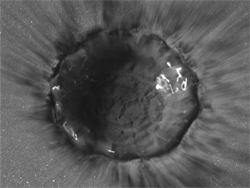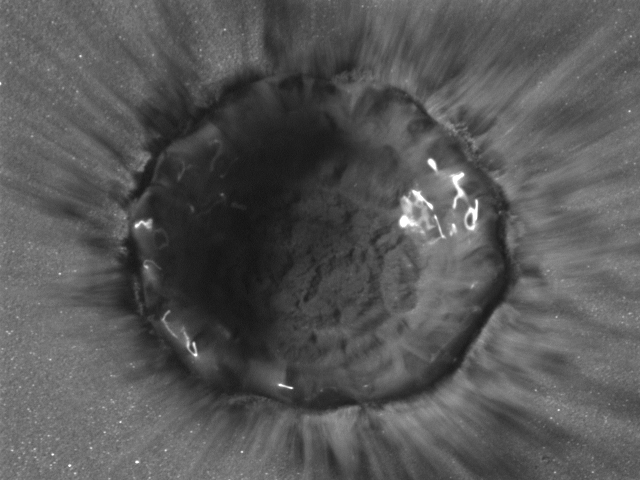Liquids Make Craters, Too
If two raindrops strike dry sand at different speeds, you might expect the faster moving raindrop to leave a bigger dent. But according to the 28 May Physical Review Letters, that isn’t necessarily true. A researcher allowed drops of water to fall from different heights onto a bed of dry granular material. He reports that medium speed drops made less of an impact than lower or higher speed drops. He also found a formula for the radius of a drop’s impact crater based on the density of the granular material, which may help researchers interpret possible signs of water in fossil records of Earth or other planets.
Many researchers have studied hard objects striking a soft layer of grains, like a golf ball hitting a sand trap. These studies have reproduced the kinds of craters seen on various moons in the solar system. Less well understood is what happens when the golf ball is replaced by a drop of water, which is capable of changing shape on impact. As far back as 1850, geologists have identified pitlike depressions in fine sand that may represent fossilized raindrops. To be certain, they need a better understanding of how water drops form impact craters.
To characterize liquid drop impacts, Hiroaki Katsuragi of Kyushu University in Japan dripped water into small dishes containing grains of silicon carbide, an abrasive material. Previously researchers varied the heights from which the water was dropped, but Katsuragi also varied the size of the granules, from 4 microns to 50 microns. Each drop was approximately 4.8 millimeters in diameter and was dropped from a height of between 10 and 480 millimeters.
Katsuragi observed a series of crater shapes, depending on the speed of impact and the size of the grains, and he used a laser measuring system to determine their depths and radii. At low speeds and small grain sizes, the drops formed what he calls “sink craters.” These are formed when the drop stays intact on impact and slowly compresses the originally “fluffy” layer of grains underneath it as the liquid sinks into the grains, leaving a 1.5-millimeter-deep depression. At medium speeds, the drop compresses the grains underneath it on impact, so they can’t be further compressed during the sinking process. These medium-speed craters were shallower than the sink craters. The highest speed drops on the smallest grains left the deepest craters, about 2 millimeters.
For the largest grain sizes, the craters were much shallower, and drops at the highest speeds left hills instead of valleys in the middle of their craters. Katsuragi suspects that in this case the drop collects grains from a wide area during the initial impact and spreading out but then deposits them in the center after the drop coalesces and sinks in.
To learn what controls the size of a crater, Katsuragi derived a formula to fit his data. He found that the radius of a crater is roughly proportional to two quantities. The first is the ratio of the grain density to the water density. If the granular layer is much denser than water, the drop deforms strongly on impact and thus makes a larger crater than for lower-density grains. The second quantity is a constant called the Weber number, which quantifies the influence of surface tension–larger or faster-moving drops have higher Weber numbers and are more likely to break apart on impact.
“This is really unexplored ground,” and not as simple as it seems, says granular dynamics researcher Devaraj van der Meer of the University of Twente in the Netherlands. “The parameter space is huge, and to define an experiment that is repeatable and gives nice results is quite difficult,” he says. The work is “inspiring,” says Daniel Goldman of the Georgia Institute of Technology, who studies the way biological structures such as “deformable lizard toes” impact sand. “Perhaps through [Katsuragi’s work] we can begin to discover principles of interaction of deformable media.”
–JR Minkel
JR Minkel is a freelance science writer in New York City.





